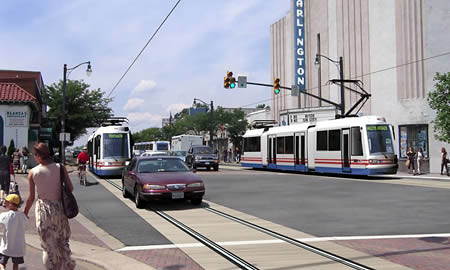This is in response to a post on an email list and I haven't included the original post. Basically the article says that money is wasted because the bus transitways are going to be replaced by a streetcar in Crystal City. The email poster said he is on the Transit Advisory Committee and voted against the streetcar because of the impact on the roadway.
Columbia Pike and the transitway through Crystal City is defined as part of Arlington County's "Primary Transit Network" (map, page 7) in the
Transit Element of the Master Transportation Plan. The element was approved in 2009 and this is what it says:
Implementation Actions
a. Implement the Crystal City/Potomac Yard Transitway with high-frequency bus service on an interim basis and with streetcar service between the Pentagon City and Braddock Road Metrorail stations. (page 6)
I am certain that this is consistent with how Arlington County has dealt with the MWCOG Transportation Policy Board for regional transportation planning and the State of Virginia Department of Rail and Public Transportation and the Federal Government in terms of planning and funding this particular project.
Over the years, I've heard a number of presentations about the transitway in Potomac Yards and the streetcar as part of Arlington County's transportation planning, by Chris Zimmerman for sure but others as well I believe, and went on a tour of this infrastructure as part of the Virginia Transit Association annual meeting a few years ago (2006 or 2007?) when it was held in Crystal City and it was always communicated that the transitways were intended for the streetcar, that bus service was a placeholder for the streetcar.
As for whether or not you support the trolley, if you care about optimal mobility, I don't see how you couldn't support it. In North America, as long as parking is mostly free and gas is relatively cheap (compared to Europe), and gas taxes are minimal, people won't ride buses. I think the last 50 years of transit experience demonstrates this decisively. The experience with BRT in the US shows this clearly.
Weighted for population, BRT lines across the US don't perform demonstratably better than DC's highest ridership bus lines. I can't see how anyone who cares about transit would believe that buses make more sense than fixed rail transit solutions, especially in the Columbia Pike corridor.
On the Georgia Avenue and H Street corridors in DC, where I have studied this, about 40% of the total throughput of the corridor takes the bus. So on H Street, that means that 15,000 people move through on an average day in 280 buses (a mix of 40' and 60') while the rest of the people move through in about 24,000 motor vehicles. Multiply this out in two dimensional or three dimensional space, and it's pretty clear that the buses move far more people in less space.
So for transit in Arlington, which is a better (more optimal) use of space? Which type of movement should be prioritized? If more people will be served and in a better quality transit environment by prioritizing transit and fixed rail transit in the Columbia Pike corridor, how could this not be in concert with the goals and objectives of the
Arlington County Master Transportation Plan?
From the
Goals and Policies Summary of the ACMTP:
Goal 1 – Provide High‐Quality Transportation Services.
Goal 2 – Move More People Without More Traffic.
Goal 3 – Promote Safety.
Goal 4 – Establish Equity.
Goal 5 – Manage Effectively and Efficiently.
Goal 6 – Advance Environmental Sustainability.
Moving more people without more traffic is the justification for transit generally and upgrading the quality and capacity of transit specifically.




0 Comments:
Post a Comment
<< Home